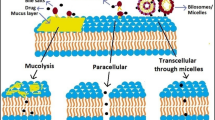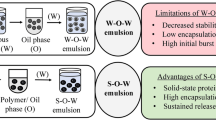Abstract
A dihydropyridine ↔ pyridinium salt redox carrier-based chemical delivery system for benzylpenicillin (1) was complexed with 2-hydroxypropyl-β-cyclodextrin (HPCD). The solubility of the lipophilic 1, which is incompatible with aqueous formulations, was dramatically increased and showed a linear dependency on the HPCD concentration. The degree of incorporation was 20 mg of 1 per g of complex. The stability study of 1 in various pH buffers indicated the base-catalyzed hydrolysis of the acyloxyalkyl linkage and the hydration of the 5,6 double bond of the dihydropyridine as the main degradation processes. The overall loss of 1, which follows first-order kinetics, was not influenced by changes in ionic strength and elimination of oxygen from the reaction medium. The HPCD complex of 1, which has a stability constant of 720–940 M −1, stabilized the chemical delivery system. The influence of the temperature on the stability of 1 is also discussed.
Similar content being viewed by others
REFERENCES
R. W. A. Barling and J. B. Selkon. The penetration of antibiotics into cerebrospinal fluid and brain tissue. J. Antimicrob. Chemother. 4:203–207 (1978).
R. Norby. A review of penetration of antibiotics into CSF and its clinical significance. Scand. J. Infect. Dis. Suppl. 14:296–309 (1978).
P. W. Kramer, R. S. Griffith, and R. L. Campbell. Antibiotic penetration of the brain. A comparative study. J. Neurosurg. 31:295–302 (1969).
R. A. Fishman. Blood-brain and CSF barriers to penicillin and related organic acids. Arch. Neurol. 15:113–124 (1966).
R. L. Dixon, E. S. Owens, and D. P. Rall. Evidence of active transport of benzyl-14C-penicillin from CSF to blood. J. Pharm. Sci. 58:1106–1109 (1969).
R. Spector and A. V. Lorenzo. Inhibition of penicillin transport from the cerebrospinal fluid after intracisternal inoculation of bacteria. J. Clin. Invest. 54:316–326 (1974).
M. S. Eisenberg, C. Furukawa, and C. C. Ray. Manual of Antimicrobial Therapy and Infectious Diseases, W.B. Saunders, Philadelphia/London/Toronto, 1980, pp. 156–159.
G. A. Nankervis. Bacterial meningitis. Med. Clin. No. Am. 58:581–592 (1974).
O. Idsoe, T. Guthe, and R. R. Wilcox. Penicillin in the treatment of syphilis. Bull. WHO 47 (Suppl):1–68 (1972).
D. R. Johns, M. Tierney, and D. Felsenstein. Alteration in the natural history of neurosyphilis by concurrent infection with the human immunodeficiency virus. N. Engl. J. Med. 316:1569–1572 (1987).
E. C. Tramont. Syphilis in the AIDS era. N. Engl. J. Med. 316:1600–1601 (1987).
P. Black, J. R. Graybill, and P. Carache. Penetration of brain abscess by systematically administered antibiotics. J. Neurosurg. 38:705-g (1973).
J. De Louvois and R. Harley. Antibiotic concentration in intracranial pus. A study from a collaboration project. Chemotherapy (Proc. 9th Int. Congr. Chemother. 1975) 4:61–71 (1975).
N. Polnikorn, R. Witoonpanich, M. Vorachit, S. Vejjajiva, and A. Vejjajiva. Penicillin concentration in cerebrospinal fluid after different treatment regimens for syphilis. Br. J. Vener. Dis. 56:363–367 (1980).
E. M. C. Dunlop, S. S. Al-Egaily, and E. T. Houang. Penicillin levels in blood and CSF achieved by treatment of syphilis. Br. Med. J. 283:646 (1981).
P. S. New and C. E. Wells. Cerebral toxicity associated with massive intravenous infusion of penicillin. Neurology 15:1053–1058 (1965).
N. Bodor. Novel approaches in prodrug design. Drugs Fut. 3:165–182 (1981).
N. Bodor. Chemical drug delivery systems. In E. B. Roche (ed.), Theory and Application of Bioreversible Carriers to Drug Design. Symposium Proceeding of Academy of Pharmaceutical Sciences, Pergamon Press, New York, 1985, pp. 95–120.
N. Bodor. Redox drug delivery systems for targeting drugs to the brain. Ann. N.Y. Acad. Sci. 507:289–306 (1987).
E. Pop, W.-M. Wu, E. Shek, and N. Bodor. Brain-specific chemical delivery systems for (β-Lactam antibiotics. Synthesis and properties of some dihydropyridine and dihydroisoquinoline derivatives of benzylpenicillin. J. Med. Chem. 32:1774–1781 (1989).
W.-M. Wu, E. Pop, E. Shek, and N. Bodor. Brain-specific chemical delivery systems for β-lactam antibiotics. In vitro and in vivo studies of some dihydropyridine and dihydroisoquinoline derivatives of benzylpenicillin in rats. J. Med. Chem. 32:1782–1789 (1989).
W.-M. Wu, E. Pop, E. Shek, R. Clemmons, and N. Bodor. Brain and CSF specific chemical delivery systems for β-lactam antibiotics. Studies of two dihydropyridine derivatives of benzylpenicillin in rabbits and dogs. Drug. Des. Deliv. 7:33–43 (1990).
E. Pop, M. E. Brewster, and N. Bodor. Central nervous system-enhanced delivery of β-lactam antibiotics. Drugs Fut. 15:473–492 (1990).
J. Szejtli. Cyclodextrins and Their Inclusion Complexes, Akademia Kiado, Budapest, 1982, pp. 3–25.
K. Uekama and M. Otagiri. Cyclodextrins in drug carrier systems. CRC Crit. Rev. Ther. Drug Syst. 3:1–40 (1987).
D. Duchene and D. Wouessidjewe. Physicochemical characteristics and pharmaceutical use of cyclodextrin derivatives, Part I. Pharm. Techn. 14:26–34 (1990).
J. Pitha, J. Mileck, H. Fales, L. Pannell, and K. Uekama. Hydroxypropyl-β-cyclodextrin; Preparation and characterization; Effects on solubility of drugs. Int. J. Pharm. 29:73–82 (1986).
T. Higuchi and K. A. Connors. Phase-solubility techniques. In C. N. Reilly (ed.), Advances in Analytical Chemistry and Instrumentation, Interscience, New York, 1965, pp. 117–212.
W. Von Daehne, W. O. Godtfredsen, K. Rohot, and L. Tybring. Pivampicillin, a new orally active ampicillin ester. Antimicrob. Agents Chemother. 1970:431–437.
T. Loftsson, S. Björnsdóttir, and N. odor. The effects of 2-hydroxypropyl-β-cyclodextrin on the solubility and stability of chlorambucil and melphalan in aqueous solution. Int. J. Pharm. 57:63–72 (1989).
F. Hirayama and K. Uekama. In D. Duchêne (ed.), Methods of Investigating and Preparing Inclusion Compounds. Cyclodextrins and Their Industrial Uses, Edition de Santé, Paris, 1987, pp. 133–172.
U. Eisner and J. Kuthan. The chemistry of dihydropyridines. Chem. Rev. 72:1–41 (1972).
D. J. Norris and R. Stewart. The pyridinium-dihydropyridinium system I. Synthesis of a series of substituted pyridinium ions and their 1,4-dihydro reduction products and a determination of their stabilities in aqueous buffers. Can. J. Chem. 55:1687–1695 (1972).
M. Brewster, K. Estes, and N. Bodor. An intravenous toxicity study of 2-hydroxypropyl-β-cyclodextrin, a useful drug solubilizer in rats and monkeys. Int. J. Pharm. 59:231–243 (1990).
Author information
Authors and Affiliations
Rights and permissions
About this article
Cite this article
Pop, E., Loftsson, T. & Bodor, N. Solubilization and Stabilization of a Benzylpenicillin Chemical Delivery System by 2-Hydroxypropyl-β-cyclodextrin. Pharm Res 8, 1044–1049 (1991). https://doi.org/10.1023/A:1015865209874
Issue Date:
DOI: https://doi.org/10.1023/A:1015865209874




